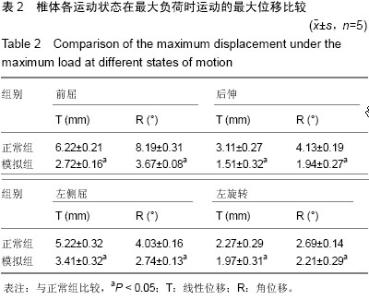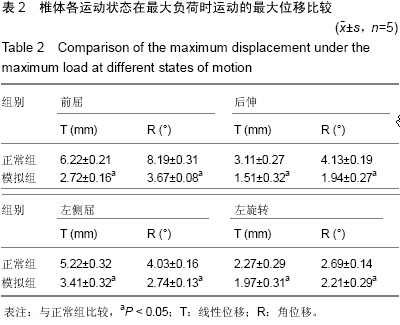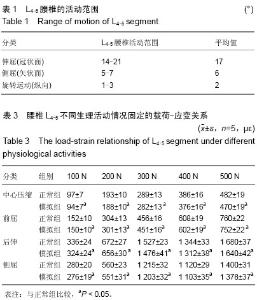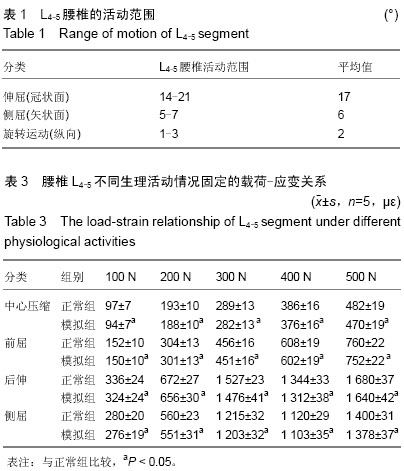Chinese Journal of Tissue Engineering Research ›› 2015, Vol. 19 ›› Issue (38): 6109-6113.doi: 10.3969/j.issn.2095-4344.2015.38.008
Previous Articles Next Articles
Biomechanical properties and biocompatibility of the L4/5 lumbar spine fusion cage
Li Liang, Jiang Mei-lin, Zhao Dun-xu
- Department of Spine Surgery, Chengyang People’s Hospital, Qingdao 266109, Shandong Province, China
-
Contact:Jiang Mei-lin, Nurse in charge, Department of Spine Surgery, Chengyang People’s Hospital, Qingdao 266109, Shandong Province, China -
About author:Li Liang, Attending physician, Department of Spine Surgery, Chengyang People’s Hospital, Qingdao 266109, Shandong Province, China -
Supported by:the Science and Technology Development for People’s Livelihood of Chengyang District, No. 2010-WSZD114; the Scientific Development Plan of Qingdao City, No. J2014034
CLC Number:
Cite this article
Li Liang, Jiang Mei-lin, Zhao Dun-xu. Biomechanical properties and biocompatibility of the L4/5 lumbar spine fusion cage[J]. Chinese Journal of Tissue Engineering Research, 2015, 19(38): 6109-6113.
share this article
| [1] 姜欢畅,王吉兴.退变性腰椎滑脱治疗的现状与争议[J].中国矫形外科杂志,2010,15(4):1285-1287. [2] 王利明,崔永峰.髌骨骨折治疗中对张力带原理的误解[J].中国骨科杂志,2010,23(2):125-127. [3] 杨明杰,李立钧,祝建光,等.数字化设计微创极外侧经椎间孔腰椎椎体间融合术[J].中华骨科杂志,2011,31:1093-1098. [4] 陈日高,屠重琪,裴福兴,等.纳米羟基磷灰石聚酰胺66 复合物椎间融合器在山羊颈椎融合中的应用[J].中国脊柱脊髓杂志, 2010, 4(20):286-290. [5] 张志,李健,杨波,等.椎弓根钉置入内固定与两种不同椎间植骨融合治疗退行性下腰椎不稳[J].中国组织工程研究与临床康复, 2010,14(30):5658-5661. [6] Villavicencio AT, Burueikiene S, Roeca CM, et al. Minimally invasive versus open transforaminal lumbar interbody fusion. Surg Neurol Int. 2010;1-12. [7] 马超,吴继彬,赵猛,等.不同手术方法治疗老年退变性腰椎滑脱合并腰椎管狭窄症疗效的比较[J].中华医学杂志,2012,92(9): 620-623. [8] 海涌,周立金,苏庆军,等.后路有限减压联合Conex动态稳定术治疗腰椎管狭窄症的临床研究[J].中国骨与关节杂志,2012, 1(1)11-16. [9] 覃琼丽,冯丽,许锋,等.环锯加盖植骨法治疗腰椎疾患的围手术期护理[J].中国临床研究,2011,24(2):165-166. [10] Karikari IO, Nimjee SM, Hardin CA, et al. Extreme lateral interbody fusion approach for isolated tlloracic and thoracolumbar spine diseases:initial clinical experience and early outcomes. J Spinal Disord Tech. 2011;24:368-375. [11] 祖丹,海涌,鲁世保,等.腰椎棘突间动态稳定装置Conex最佳置入位置的生物力学研究[J].中华外科杂志,2014,52(3):179-183. [12] Hartmann F, Dietz S, Hely H, et al. Biomechanical efkct of difkrent interspinous devices on lumbar 8pinal mnge of motion under preload conditions. Arch Orthop Trauma Surg. 2011;131(7):917-926. [13] Kaibara T, Karabalios DG, Porier RW, et al. Biomechanics of a lumbar interspinous anchor with transforaminal lumbar interbody fixation. World Neurosurg. 2010;73:572-577. [14] 张中兴,许峰,金伟,等.环锯加盖植骨法在腰椎滑脱术中的应用[J].中国临床研究,2011,24(1):43-44. [15] 李健,张振山,赵洪普,等.自体颗粒骨打压植骨腰椎椎体问融合术治疗下腰椎退变性不稳的疗效[J].广州医学院学报, 2010,38(5): 24-27. [16] Toukas V, Mtiller A. Minimally invasive approach versus traditional open approach for one level posterior lumbar interbody fusion. Minim Invasive Neurosurg. 2010;53:21-24. [17] 董健文,邱奕雁,赵卫东,等.单侧椎弓根钉棒固定单节段腰椎及其邻近节段生物力学研究[J].中国临床解剖学杂志,2010,28(1): 85-89. [18] 李春海,叶伟,李鉴轶,等.后路椎间融合对不同程度小关节切除腰椎稳定性的影响[J].中国临床解剖学杂志,2009,27(1):93-95. [19] Arnold PM, Robbins S, Paullus W, et al. Clinical outcomes of lumbar degenerative disc disease treated with posterior lumbar interbody fusion allograft spacer: a prospective, multicenter trial with 2-year follow-up. Am J Orthop (Belle Mead NJ). 2009;38(7):E115-E122. [20] 马金梁,李孝林,邓惠良.一种新型椎间融合器用于腰椎融合的有限元模型建立[J].上海医学,2012,35(11):960-963. [21] 孙永生,孙卫东,温建民,等.腰椎后路椎体间融合术的改良:椎间融合器植入联合椎体间颗粒状骨加压植骨术[J].中华损伤与修复杂志(电子版),2010,5(5):13-18. [22] 廖壮文,范子文,杨进顺,等.自制一体成型式皮质骨生物型腰椎间融合器在腰椎后路椎间融合术中的中远期疗效[J].广西医学, 2014,35(20):3214-3217. [23] Smith AJ, Arginteanu M, Moore F, et al. Increased incidence of cage migration and nonunion in instrumented transforaminal lumbar interbody fusion with bioabsorbable cages. J Neurosurg Spine. 2010;13(3):388-393. [24] 张俊,何宏生,袁房均,等.椎间盘镜下腰椎钉棒置入内固定椎间融合物的特点与选择[J].中国组织工程研究与临床康复,2011, 15(43):8142-8146. [25] 苗惊雷,张朝跃,詹瑞森,等.置入椎间融合器行腰椎融合后Cage移位的原因[J].中国组织工程研究与临床康复,2011,15(39): 7307-7310. [26] 张继东,夏群,胡永成,等.前路腰椎椎间融合术即刻稳定性的生物力学研究[J].中华骨科杂志,2010,30(5):492-496. [27] Mariano FF, Pedro S, Hernan R, et al. A prospective randomized study of unilateral versus bilateral instrumented posterolateral lumbar fusion in degenerative spondylolisthesis. Spine. 2007;32(4):395-401. [28] 李洋,罗飞,刘鹏,等.新型后路同种异体骨解剖形腰椎融合器的疗效[J].实用医学杂志,2014,30(7):1112-1115. [29] 夏群,苗军,张继东,等.单纯椎问融合器腰椎前路融合术治疗腰椎退变性疾病[J].中华骨科杂志,2011,31(10):1159-1164. [30] Urrutia J, Molina M. Fresh-frozen femoral head allograft as lumbar interbody graft material allows high fusion rate without subsidence. Orthop Traumatol Surg Res. 2013;99(4): 413-418. [31] Malham GM, Parker RM, Blecher CM, et al. Assessment and classification of subsidence after lateral interbody fusion using serial computed tomography. J Neurosurg Spine. 2015:1-9. [32] Yeager MS, Dupre DA, Cook DJ, et al. Anterior lumbar interbody fusion with integrated fixation and adjunctive posterior stabilization: a comparative biomechanical analysis. Clin Biomech (Bristol, Avon). 2015. [33] Kim SM, Rhee W, Ha S, et al. Influence of alendronate and endplate degeneration to single level posterior lumbar spinal interbody fusion. Korean J Spine. 2014;11(4):221-226. [34] Vokshoor A, Khurana S, Wilson D, et al. Clinical and radiographic outcomes after spinous process fixation and posterior fusion in an elderly cohort. Surg Technol Int. 2014;25:271-276. [35] Yang M, Zeng C, Guo S, et al. Digitalized design of extraforaminal lumbar interbody fusion: a computer-based simulation and cadaveric study. PLoS One. 2014;9(8): e105646. [36] Fogel GR, Turner AW, Dooley ZA, et al. Biomechanical stability of lateral interbody implants and supplemental fixation in a cadaveric degenerative spondylolisthesis model. Spine (Phila Pa 1976). 2014;39(19):E1138-E1146. |
| [1] | Chen Ziyang, Pu Rui, Deng Shuang, Yuan Lingyan. Regulatory effect of exosomes on exercise-mediated insulin resistance diseases [J]. Chinese Journal of Tissue Engineering Research, 2021, 25(25): 4089-4094. |
| [2] | Chen Yang, Huang Denggao, Gao Yuanhui, Wang Shunlan, Cao Hui, Zheng Linlin, He Haowei, Luo Siqin, Xiao Jingchuan, Zhang Yingai, Zhang Shufang. Low-intensity pulsed ultrasound promotes the proliferation and adhesion of human adipose-derived mesenchymal stem cells [J]. Chinese Journal of Tissue Engineering Research, 2021, 25(25): 3949-3955. |
| [3] | Yang Junhui, Luo Jinli, Yuan Xiaoping. Effects of human growth hormone on proliferation and osteogenic differentiation of human periodontal ligament stem cells [J]. Chinese Journal of Tissue Engineering Research, 2021, 25(25): 3956-3961. |
| [4] | Sun Jianwei, Yang Xinming, Zhang Ying. Effect of montelukast combined with bone marrow mesenchymal stem cell transplantation on spinal cord injury in rat models [J]. Chinese Journal of Tissue Engineering Research, 2021, 25(25): 3962-3969. |
| [5] | Gao Shan, Huang Dongjing, Hong Haiman, Jia Jingqiao, Meng Fei. Comparison on the curative effect of human placenta-derived mesenchymal stem cells and induced islet-like cells in gestational diabetes mellitus rats [J]. Chinese Journal of Tissue Engineering Research, 2021, 25(25): 3981-3987. |
| [6] | Hao Xiaona, Zhang Yingjie, Li Yuyun, Xu Tao. Bone marrow mesenchymal stem cells overexpressing prolyl oligopeptidase on the repair of liver fibrosis in rat models [J]. Chinese Journal of Tissue Engineering Research, 2021, 25(25): 3988-3993. |
| [7] | Liu Jianyou, Jia Zhongwei, Niu Jiawei, Cao Xinjie, Zhang Dong, Wei Jie. A new method for measuring the anteversion angle of the femoral neck by constructing the three-dimensional digital model of the femur [J]. Chinese Journal of Tissue Engineering Research, 2021, 25(24): 3779-3783. |
| [8] | Meng Lingjie, Qian Hui, Sheng Xiaolei, Lu Jianfeng, Huang Jianping, Qi Liangang, Liu Zongbao. Application of three-dimensional printing technology combined with bone cement in minimally invasive treatment of the collapsed Sanders III type of calcaneal fractures [J]. Chinese Journal of Tissue Engineering Research, 2021, 25(24): 3784-3789. |
| [9] | Qian Xuankun, Huang Hefei, Wu Chengcong, Liu Keting, Ou Hua, Zhang Jinpeng, Ren Jing, Wan Jianshan. Computer-assisted navigation combined with minimally invasive transforaminal lumbar interbody fusion for lumbar spondylolisthesis [J]. Chinese Journal of Tissue Engineering Research, 2021, 25(24): 3790-3795. |
| [10] | Hu Jing, Xiang Yang, Ye Chuan, Han Ziji. Three-dimensional printing assisted screw placement and freehand pedicle screw fixation in the treatment of thoracolumbar fractures: 1-year follow-up [J]. Chinese Journal of Tissue Engineering Research, 2021, 25(24): 3804-3809. |
| [11] | Shu Qihang, Liao Yijia, Xue Jingbo, Yan Yiguo, Wang Cheng. Three-dimensional finite element analysis of a new three-dimensional printed porous fusion cage for cervical vertebra [J]. Chinese Journal of Tissue Engineering Research, 2021, 25(24): 3810-3815. |
| [12] | Wang Yihan, Li Yang, Zhang Ling, Zhang Rui, Xu Ruida, Han Xiaofeng, Cheng Guangqi, Wang Weil. Application of three-dimensional visualization technology for digital orthopedics in the reduction and fixation of intertrochanteric fracture [J]. Chinese Journal of Tissue Engineering Research, 2021, 25(24): 3816-3820. |
| [13] | Sun Maji, Wang Qiuan, Zhang Xingchen, Guo Chong, Yuan Feng, Guo Kaijin. Development and biomechanical analysis of a new anterior cervical pedicle screw fixation system [J]. Chinese Journal of Tissue Engineering Research, 2021, 25(24): 3821-3825. |
| [14] | Lin Wang, Wang Yingying, Guo Weizhong, Yuan Cuihua, Xu Shenggui, Zhang Shenshen, Lin Chengshou. Adopting expanded lateral approach to enhance the mechanical stability and knee function for treating posterolateral column fracture of tibial plateau [J]. Chinese Journal of Tissue Engineering Research, 2021, 25(24): 3826-3827. |
| [15] | Zhu Yun, Chen Yu, Qiu Hao, Liu Dun, Jin Guorong, Chen Shimou, Weng Zheng. Finite element analysis for treatment of osteoporotic femoral fracture with far cortical locking screw [J]. Chinese Journal of Tissue Engineering Research, 2021, 25(24): 3832-3837. |
| Viewed | ||||||
|
Full text |
|
|||||
|
Abstract |
|
|||||



